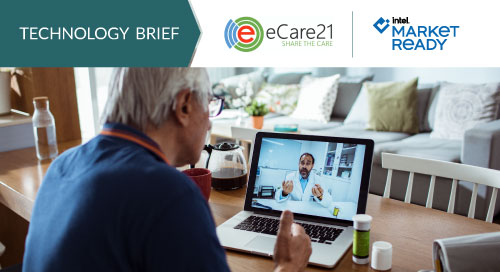Telehealth: The Future of Patient Care

Telehealth has undergone a renaissance. While the concept has long held appeal, it’s been stuck in eternal “pilot purgatory,” plagued by a patchwork of healthcare technologies and clinicians weary of reimbursement hassles. But when COVID hit, adoption surged, providing a way to mitigate a dramatic fall in private practice and hospital revenue.
As providers saw firsthand the many benefits, including more-efficient visits and better outcomes for their patients, they have embraced telehealth as a vital avenue for care. “Acceptance of telehealth had been at a crawl, but COVID made it a sprint. Now we’ve crossed the chasm and burned the bridge behind us,” says eCare21 Chief Revenue Officer Gary Holderby.
A New Standard for Patient Monitoring
One area showing particular promise is remote patient monitoring (RPM). Nearly three-quarters of providers report they would like to continue offering chronic disease management to patients via telehealth even after COVID-19 protocols ease.
That’s where the eCare21 Virtual Care platform comes in, offering a streamlined path that addresses the challenges telehealth has previously faced. Its comprehensive integration features a single, intuitive user interface that eliminates data silos that make coordinated care challenging. And importantly, it provides an audit trail that offers billing capabilities that support seamless reimbursement.
As Holderby explains, the virtual health solution evolved from its initial use for senior care. The company began aggressively building increased functionalities into the platform to accommodate diverse patient needs, such as remotely checking blood pressure, managing prescriptions, and verifying people were following their doctor’s advice. Soon the company had created a virtual cloud-based ecosystem that supported what had previously been disparate technologies.
“The interoperability wasn’t there—there were too many contracts and too many different technologies. To the industry it was like they were being sold a car one part at a time and expected to tie all those together on the back end,” Holderby says. “We knew that theprevious fragmentation was not sustainable, and healthcare providers were ready to evolve to a simplified solution.”
At its core, the communication platform gives providers a single source to view and act on critical inputs in real time. It addresses current gaps between caregivers, primary physicians, and specialists such as cardiologists by ensuring everyone has access to the same information. And it provides a secure repository for medical records that follow patients, eliminating a major hurdle in coordinating and managing care.
“Taken together, these capabilities allow providers to get back to the joy of their work because they are practicing at the top of their license.” @gholderby @eCare21
AI Technology Provides Ongoing Triage
Through the simple, comprehensive dashboard, patients are monitored 24/7. Every time a reading comes in, the AI capability evaluates it and generates an alert if it’s out of the range that was set. That notifies medical assistants or nurses who can act on it as needed, contacting providers only with an escalation they can’t manage. This constant stream of information also eliminates arbitrary requirements that patients undergo checkups on a predetermined timetable since any potential issues already will have been flagged.
“Taken together, these capabilities allow providers to get back to the joy of their work because they are practicing at the top of their license,” Holderby says.
Healthcare Tech: Flexibility at Its Foundation
Cloud-based and device-agnostic, the solution is easy to deploy with patients wearing any type of smart device, located anywhere in the world. “We’re flexible to the device, the clinical workflow, and the billing engine,” says Pete Stevenson, eCare21’s president and COO. “And that ability to upgrade or pivot as needed was vital, as the industry was wary to commit to one type of technology in case something better was introduced.”
Partnering with solutions providers has allowed the company to scale quickly. It realized early on that to impact more lives more quickly it needed to supplement the business model with systems integrators. “These companies are already out there, pulling together multiple solutions—it’s in their DNA and their mindset,” Holderby says. Intel® and Dell technology and partnerships have been essential to the company’s plug-and-play model.
Creating a Path for Value-Based Care
Reimbursement remains one of the most pressing problems in healthcare. While it has long operated on a fee-for-service model—where each service represents additional revenue—the future is value-based care, which incents providers to keep patients healthy and out of the emergency room. Yet providers have previously lacked a tool to monitor or help patients once they were discharged, a hurdle that eCare21 removes with its transparency into patients’ behavior and symptoms.
“As the system moves to an incentive-based payment model, providers are thirsty for solutions that offer insight into patients’ behavior at home,” says Holderby. ”It’s in the lived environment where they become noncompliant, and that is where costs escalate.” Keeping an eye on readings to allow early detection means that providers can step in at the first sign of an issue and intervene before a patient winds up in the hospital.